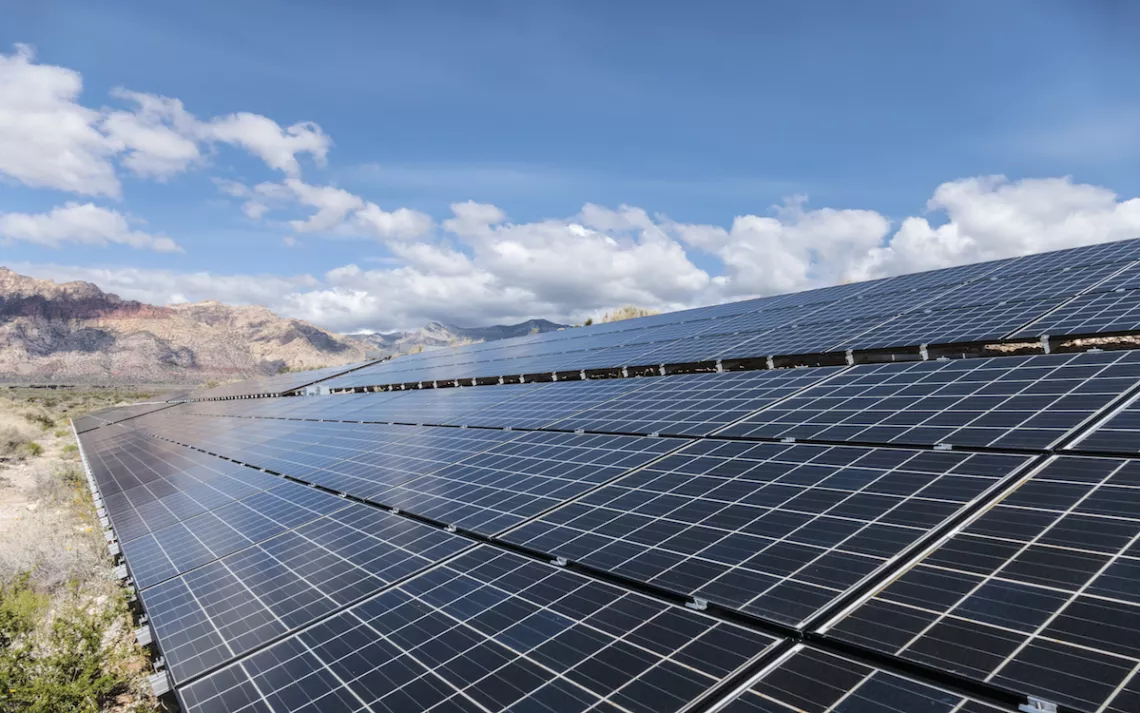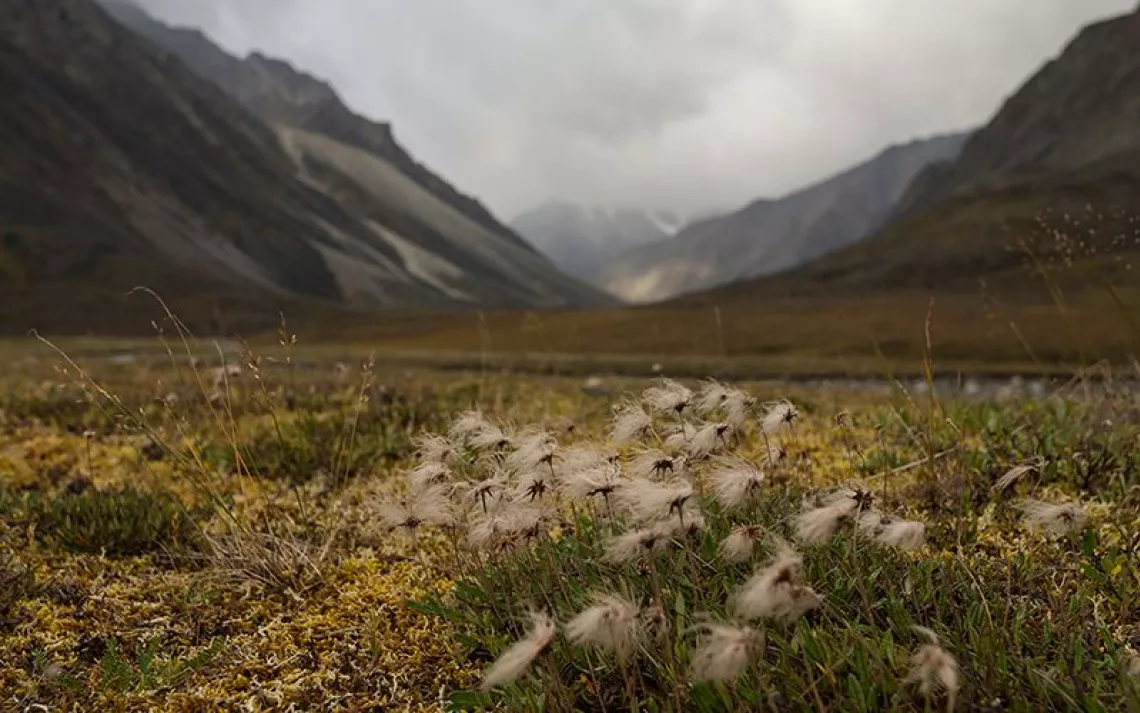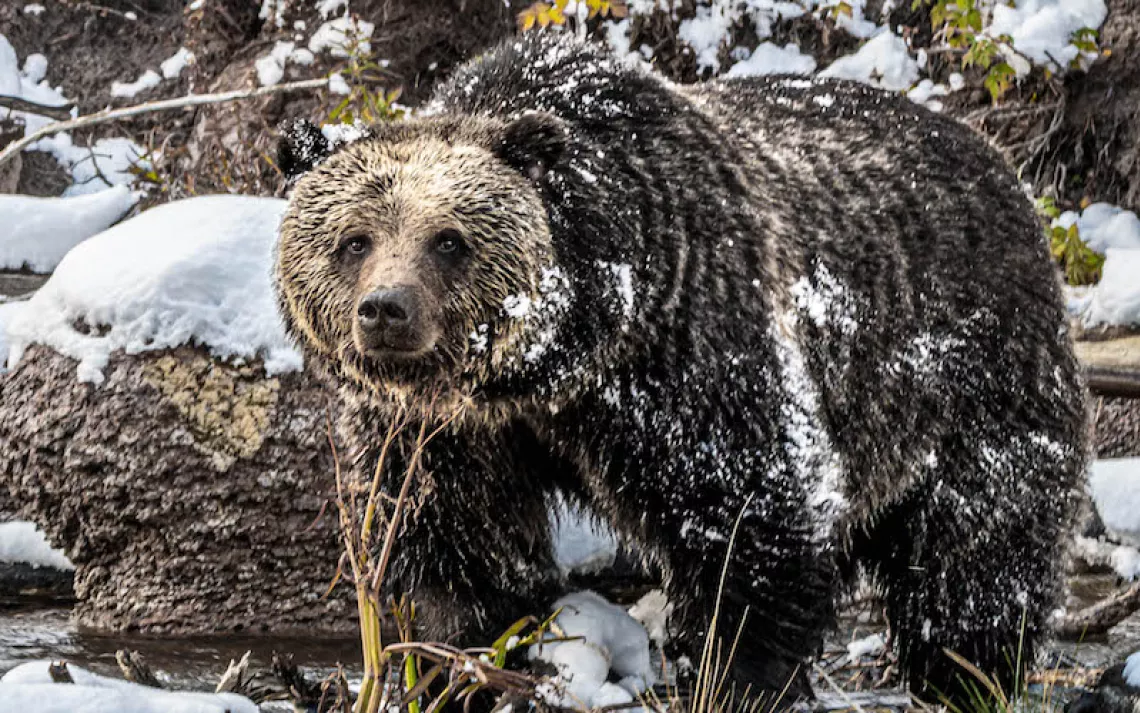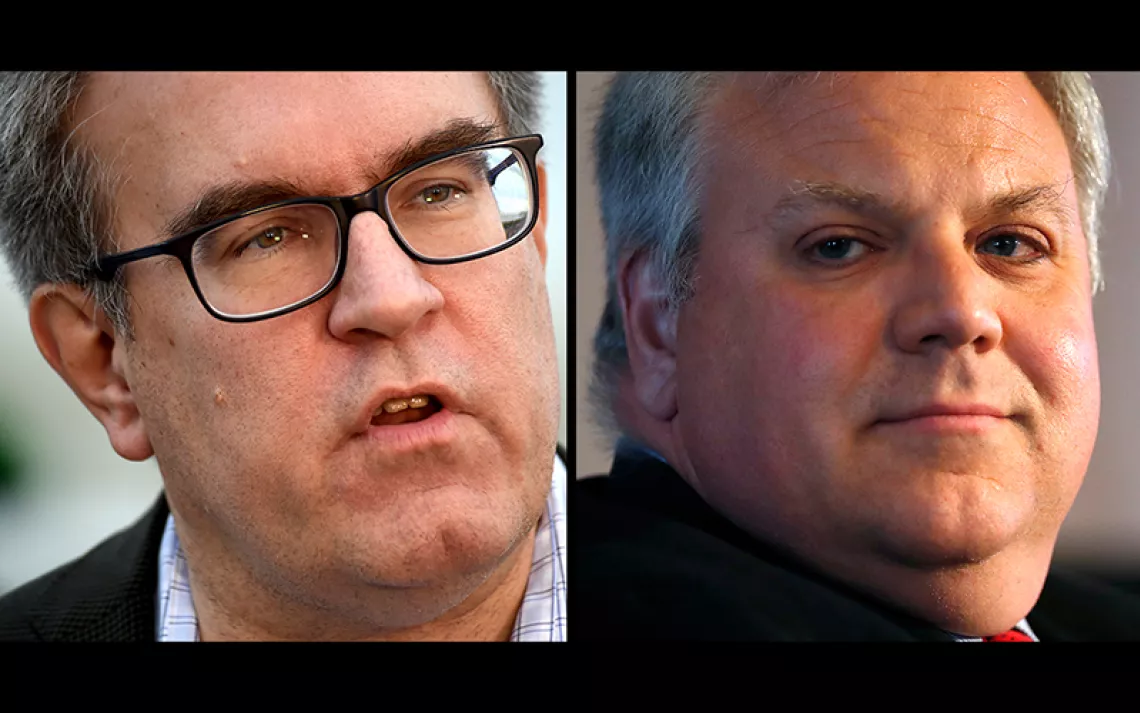Trump Administration Bulldozes Desert Conservation Plan
BLM's actions threaten to reignite conflicts over fate of California desert

Solar panels in a desert landscape | Photo by iStock/trekandshoot
In 2016, then–Republican presidential candidate Donald Trump asked radio host Herman Cain if he had ever been to Palm Springs. “It looks like a junkyard,” Trump proclaimed, thanks to the wind turbines around the city. He continued, “You know, you’re driving into Palm Springs, California, and it looks like a poor man’s version of Disneyland. It’s the worst thing you’ve ever seen."
According to Trump, the problem with wind energy is that it is “very, very expensive” and “only works when it’s windy.” He said he was sympathetic to the wildlife, decrying turbines for killing eagles “by the hundreds.”
Two years later, the winds appear to have changed for the president’s approach to renewable energy in the California desert. Though it may seem surprising, the Trump administration is pushing a policy that could increase renewable energy development, at least in this one location.
In February, the Trump administration announced it would consider reviewing the Bureau of Land Management's (BLM) Desert Renewable Energy Conservation Plan, an Obama-era land-use blueprint developed to balance wildlands conservation with the growing demand for clean energy on public land in the California desert, one of the largest intact ecosystems in the Lower 48.
According to the BLM’s press release, the review stems from Trump's March 2017 executive order to promote “energy dominance,” which instructs federal agencies to "immediately review existing regulations that potentially burden the development or use of domestically produced energy resources." The BLM opened a 45-day public comment period that closed on March 22 and has hosted eight meetings across the state for communities and stakeholders.
The move has reignited a heated conflict between renewable energy developers and desert conservationists. The two may seem like natural partners in the effort to protect our planet and its resources. But as any traveler tricked by a mirage can tell you, nothing is as it seems in the desert.
The Desert Renewable Energy Conservation Plan (DRECP is the unwieldy acronym) was developed over the course of eight years by a coalition of stakeholders including conservationists, renewable energy developers, mining companies, off-road vehicle groups, and county officials. The development of the plan began in 2008, as a renewable energy “gold rush” led to solar and wind developers proposing projects all across the Southern California desert. Area conservationists were concerned that the projects would haphazardly slice up the desert if measures weren’t put in place to protect the sensitive ecosystems.
Of the 10.8 million acres covered by DRECP, 6.5 million acres are set aside for conservation areas to protect habitats for dozens of species such as desert tortoises, Mojave fringe-toed lizards, and golden eagles. Just over 800,000 acres—about 7 percent of the total—was made available for renewable energy development. About half of that, or roughly 388,000 acres, are considered “Development Focus Areas”: land where development would not disrupt major habitats and which has easy access to existing infrastructure like transmission lines and roads.
Though various wind, solar, and geothermal companies were involved in the development of DRECP, they have criticized the plan for choking renewable energy development. Since the BLM put the plan into place, the agency has not received any filings for new projects on public lands in the California desert, even though wind and solar energy development is ramping up across the United States.
Shannon Eddy, executive director of the Large-Scale Solar Association, a California trade group, told the Desert Sun that the plan in its current form "all but forecloses new renewable energy." Eddy said her group is "cautiously optimistic” about reopening the plan. "Perhaps now we will have an opportunity to develop a plan that truly brings together conservation with viable renewable development where it's most appropriate," Eddy said.
Nancy Rader, executive director of the California Wind Energy Association, also was dissatisfied with the way DRECP negotiations played out. She claims that the Development Focus Areas show little overlap with areas that are good for wind energy and that conservationists were not willing to budge on allowing development in areas set aside for protection. The areas considered appropriate for wind development on BLM land comprise 78,779 acres (about 4 percent) of the 2.1 million acres of high-quality wind resources in the DRECP area.
“California doesn’t have a lot of wind energy resources to begin with,” Rader told Sierra. “The desert is the only place left in California with wind resources that are good enough to develop.”
Renewable energy companies often cite California’s lofty renewable energy mandates as the reason for ramping up development. In 2015, Governor Jerry Brown signed into law a measure requiring publicly owned utilities and other power companies to get 50 percent of their energy from renewable sources by 2030. California utilities have already contracted for most of the electricity they need to meet the state's 50 percent renewable energy mandate. But Rader claims that much of that is due to the fact that Community Choice Aggregation (CCA) utilities are gaining popularity across California and diverting customers away from California’s three investor-owned utility companies. Fewer customers means less renewable energy is needed for the companies to achieve the state’s goals, and CCA utilities are less clear on reporting their progress on meeting the renewable mandates.
Rader also worries that the lack of new renewable energy projects means that California won’t be able to meet its energy goals beyond 2030 with the current DRECP. “I’m mystified by environmentalists treating wind and solar with the same brush,” Rader complains. “Wind only causes 3 percent disturbance on the land, and that’s not the case for solar.”
Rader and other renewable energy developers feel that some conservationists have “lost perspective.” She said, “We’re not going to be able to get off of fossil fuels unless we have a lot of wind energy, and it’s going to take some land. If we don’t get off fossil fuels, forget the desert tortoise.”
Conservationists see the situation differently. “This is an attack on conservation,” says David Lamfrom, director of the California Desert and National Wildlife Program at the National Parks Conservation Association. “This is ideological.”
According to Lamfrom, renewable energy developers had their say at the DRECP negotiating table, and “for them to admit that they’re trying to get a better deal is for them to admit that they put together a plan that didn’t work for them.” Besides, he says, desert conservationists do not aim to stop all renewable energy development in the desert but rather ensure that development is done carefully.
The desert’s arid ecosystems are sensitive. Desert soil takes a long time to recover from disturbances because of the lack of water, slow nutrient cycling, and slow plant growth. The average time for the reestablishment of perennial plant cover in the Mojave and Sonoran Deserts is an estimated 76 years. “Once these lands are bulldozed for either wind turbines or solar panels, they will never be replaced by the native habitat they once provided,” said Tom Egan, California desert representative for Defenders of Wildlife. “Restoration of arid habitats like the Mojave Desert is next to impossible. You will never get back what you lose.”
Past experiences show this to be true. The impacts of the Ivanpah Solar Electric Generating System on the area’s desert tortoise and bird populations are well documented. Inappropriately cited wind turbines can impact migratory birds, one reason why Audubon praised DRECP for safeguarding sensitive desert bird species while pursuing renewable energy goals.
Desert conservationists also point out that the Mojave Desert has been found to be a significant carbon sink—and just as protecting land helps reduce carbon, disturbing it could exacerbate greenhouse gas emissions. Studies show that damaging desert soils can release significant amounts of carbon dioxide into the atmosphere.
“It’s very important that we move quickly on renewable energy, but we have to recognize that where we put these projects matters,” Lamfrom said. “Some of these projects are the size of a city. It is important that they are put in the right places, otherwise they can be catastrophic.”
Conservationists are also frustrated that DRECP has been unceremoniously reopened after years of hard work. Over the course of its development, DRECP went through severe growing pains. In 2015, renewable energy developers and conservationists wrote an unusual joint letter to federal officials in which they complained about the plan’s “pervasive lack of clarity.” But by the time the plan was completed in the fall of 2016, it represented an achievement across coalitions. “The plan as it stands was the product of eight years of compromise and coordination and collaboration,” said Frazier Haney, conservation director at the Mojave Desert Land Trust. “If we open the plan now and undo that compromise, we could be making it more difficult to permit appropriate renewable energy in the desert.”
Moreover, the current plan has barely been in place long enough to be implemented. “The plan is only 17 months old. The ink has barely dried on the document, and it hasn’t actually been implemented yet,” said Jora Fogg, policy director at Friends of the Inyo. “We really have to allow this plan some time to work and see what issues need to be corrected.”
Mojave Desert residents have come out in droves against reopening DRECP. A February op-ed in the Hi-Desert Star declared that “local residents see the degradation of the [Morongo] Basin’s air quality from existing solar developments” where “desert crust is scraped and vegetation removed.” Many of these communities rely on tourism dollars that could be compromised by further development of wildlands. Jane Smith, whose family runs the 29 Palms Inn near Joshua Tree National Park, told the Desert Sun at a public scoping meeting that tourists "don't want to see solar and wind scattered across our beautiful desert."
Even if renewable energy developers and conservationists don’t agree on the content of the current plan, there is general consensus that the Trump administration’s rollback is unorthodox.
“There are probably some tweaks that can be easily addressed in the implementation phase of this plan rather than completely reopening the DRECP,” said Egan from Defenders of Wildlife. “The original public comment period allowed for at least twice the time that the BLM has given for . . . this initial notice. . . . And the BLM has given us no parameters relative to the change that they are considering.”
“Obviously the optics aren’t great,” Rader admitted. “But we’re looking at this very narrowly. We’re looking at providing access for wind energy development. We’re not really addressing anything else.”
Martha Maciel, deputy state director for communications at BLM California, emphasized that the future of the current plan, as well as any changes that may be made after the review, are “uncertain at this time.”
For the renewable energy developers, taking advantage of the Trump administration’s tactics could be like playing Russian roulette. There is no guarantee that reopening the plan will lead to the outcome that they envision. Reopening the plan, after all, also provides opportunities for other interest groups such as mining companies, ranchers, and off-road vehicle enthusiasts to change the current land-use formulas. Add that to the fact that Interior Secretary Ryan Zinke recently compared wind energy’s carbon footprint to nonrenewable sources while decrying turbines for “chop[ping] up birds” and has already opened 1.3 million acres of California desert to mining.
“More than anything, it’s the uncertainty,” Fogg said. “People aren’t sure if they’re going to end up with more renewable energy development in the county or lose their access to recreation areas and conservation. People are concerned about any kind of development on public lands that would impact the quality of life.”
 The Magazine of The Sierra Club
The Magazine of The Sierra Club



